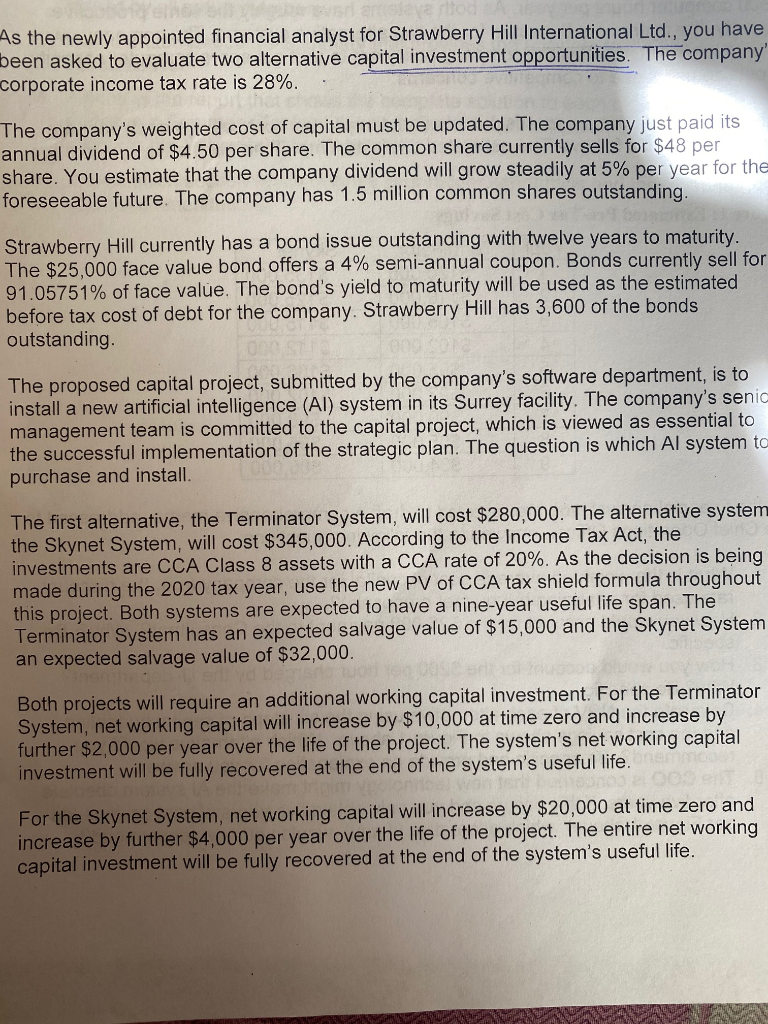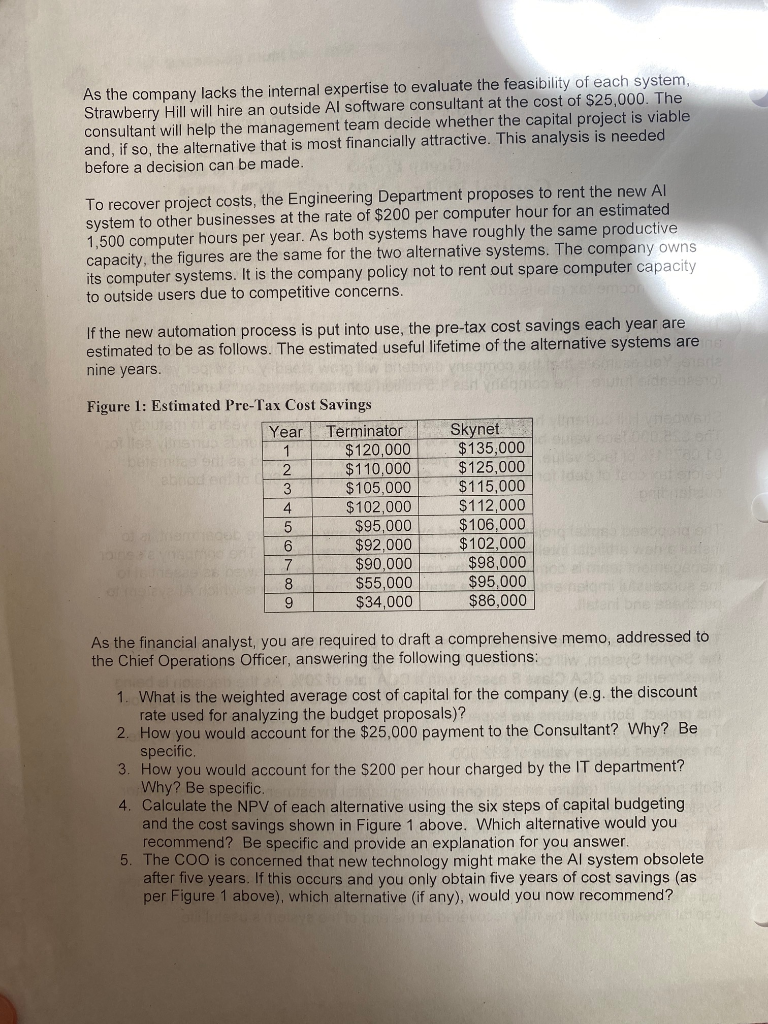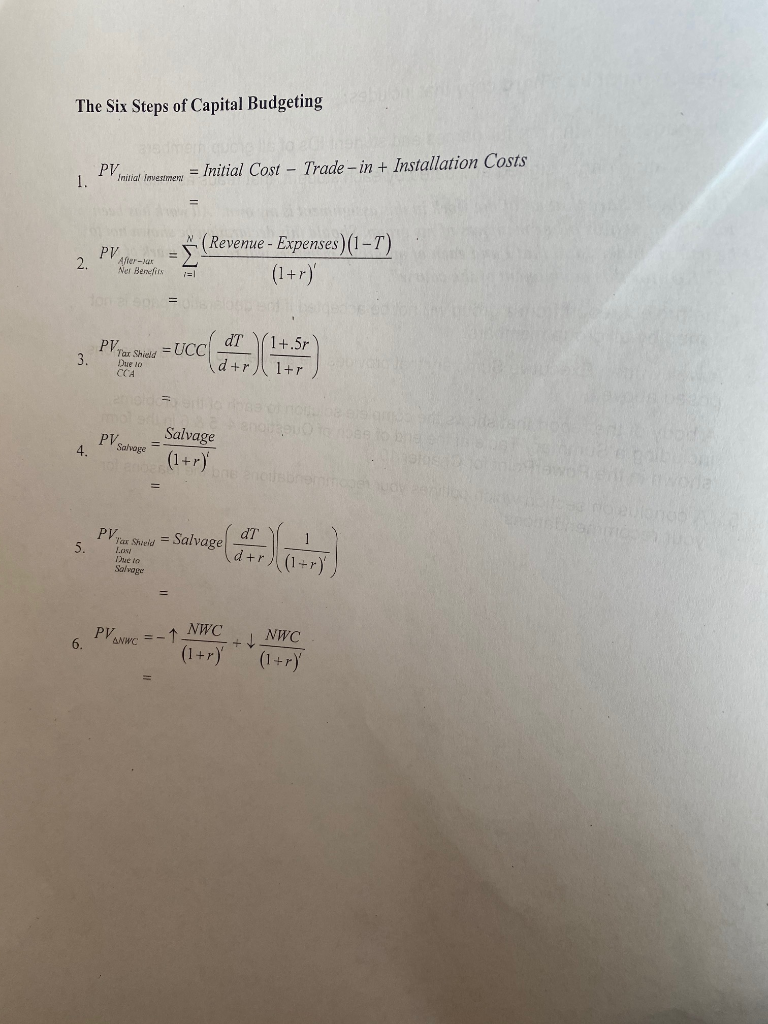Answered step by step
Verified Expert Solution
Question
1 Approved Answer
ALSO PLEASE INCLUDE THE CONCLUSION As the newly appointed financial analyst for Strawberry Hill International Ltd., you have been asked to evaluate two alternative capital




ALSO PLEASE INCLUDE THE CONCLUSION
As the newly appointed financial analyst for Strawberry Hill International Ltd., you have been asked to evaluate two alternative capital investment opportunities. The company corporate income tax rate is 28%. The company's weighted cost of capital must be updated. The company just paid its annual dividend of $4.50 per share. The common share currently sells for $48 per share. You estimate that the company dividend will grow steadily at 5% per year for the foreseeable future. The company has 1.5 million common shares outstanding. Strawberry Hill currently has a bond issue outstanding with twelve years to maturity. The $25,000 face value bond offers a 4% semi-annual coupon. Bonds currently sell fon 91.05751% of face value. The bond's yield to maturity will be used as the estimated before tax cost of debt for the company. Strawberry Hill has 3,600 of the bonds outstanding. The proposed capital project, submitted by the company's software department, is to install a new artificial intelligence (AI) system in its Surrey facility. The company's senic management team is committed to the capital project, which is viewed as essential to the successful implementation of the strategic plan. The question is which Al system to purchase and install. The first alternative, the Terminator System, will cost $280,000. The alternative system the Skynet System, will cost $345,000. According to the Income Tax Act, the investments are CCA Class 8 assets with a CCA rate of 20%. As the decision is being made during the 2020 tax year, use the new PV of CCA tax shield formula throughout this project. Both systems are expected to have a nine-year useful life span. The Terminator System has an expected salvage value of $15,000 and the Skynet System an expected salvage value of $32,000. Both projects will require an additional working capital investment. For the Terminator System, net working capital will increase by $10,000 at time zero and increase by further $2,000 per year over the life of the project. The system's net working capital investment will be fully recovered at the end of the system's useful life. For the Skynet System, net working capital will increase by $20,000 at time zero and increase by further $4,000 per year over the life of the project. The entire net working capital investment will be fully recovered at the end of the system's useful life. As the company lacks the internal expertise to evaluate the feasibility of each system, Strawberry Hill will hire an outside Al software consultant at the cost of $25,000. The consultant will help the management team decide whether the capital project is viable and, if so, the alternative that is most financially attractive. This analysis is needed before a decision can be made. To recover project costs, the Engineering Department proposes to rent the new All system to other businesses at the rate of $200 per computer hour for an estimated 1,500 computer hours per year. As both systems have roughly the same productive capacity, the figures are the same for the two alternative systems. The company owns its computer systems. It is the company policy not to rent out spare computer capacity to outside users due to competitive concerns. If the new automation process is put into use, the pre-tax cost savings each year are estimated to be as follows. The estimated useful lifetime of the alternative systems are nine years. Figure 1: Estimated Pre-Tax Cost Savings Year Terminator $120,000 $110,000 ebode $105,000 $102,000 $95,000 $92,000 $90,000 $55,000 $34,000 VOOWN Skynet $135,000 $125,000 $115,000 $112,000 $106,000 $102,000 $98,000 $95,000 $86,000 As the financial analyst, you are required to draft a comprehensive memo, addressed to the Chief Operations Officer, answering the following questions: 1. What is the weighted average cost of capital for the company (e.g. the discount rate used for analyzing the budget proposals)? 2. How you would account for the $25,000 payment to the Consultant? Why? Be specific 3. How you would account for the $200 per hour charged by the IT department? Why? Be specific. 4. Calculate the NPV of each alternative using the six steps of capital budgeting and the cost savings shown in Figure 1 above. Which alternative would you recommend? Be specific and provide an explanation for you answer. 5. The coo is concerned that new technology might make the Al system obsolete after five years. If this occurs and you only obtain five years of cost savings (as per Figure 1 above), which alternative (if any), would you now recommend? Each submission must be a hard copy that includes: 1. A title page, showing the full names and student IDs of all group members 2. A declaration page, signed and dated by each student, that reads as follows "I hereby declare that all of the work in this assignment is my own. All work has been done by myself or other members of my group. Should this declaration be shown not to be true, I understand that I and each of my group members will receive a mark of 0% (ZERO) for this component of the course" The project report from a group will not be accepted if the declaration page is not signed by all group members. 3. A well written Executive Summary that provides the answers to the five questions posed above. 4. A body of the report that shows the complete solution to each of the problems, including a Summary Table at the end of each of Questions 4,5 & 6 in the form shown in the PowerPoint for Chapter 10. 5. A conclusion section which outlines your recommendations and the reasons for your recommendations. The Six Steps of Capital Budgeting PV miniat imesimen = Initial Cost - Trade-in + Installation Costs (Revenue - Expenses)(1-T) PV Aller-la Ner Benefits 1=1 =BO Salvage Salvage (1+r) s. Pens + Salvage ( ) Due to Salvage (1+r) PV = -1 NWC (1+r) NWC (1+r) As the newly appointed financial analyst for Strawberry Hill International Ltd., you have been asked to evaluate two alternative capital investment opportunities. The company corporate income tax rate is 28%. The company's weighted cost of capital must be updated. The company just paid its annual dividend of $4.50 per share. The common share currently sells for $48 per share. You estimate that the company dividend will grow steadily at 5% per year for the foreseeable future. The company has 1.5 million common shares outstanding. Strawberry Hill currently has a bond issue outstanding with twelve years to maturity. The $25,000 face value bond offers a 4% semi-annual coupon. Bonds currently sell fon 91.05751% of face value. The bond's yield to maturity will be used as the estimated before tax cost of debt for the company. Strawberry Hill has 3,600 of the bonds outstanding. The proposed capital project, submitted by the company's software department, is to install a new artificial intelligence (AI) system in its Surrey facility. The company's senic management team is committed to the capital project, which is viewed as essential to the successful implementation of the strategic plan. The question is which Al system to purchase and install. The first alternative, the Terminator System, will cost $280,000. The alternative system the Skynet System, will cost $345,000. According to the Income Tax Act, the investments are CCA Class 8 assets with a CCA rate of 20%. As the decision is being made during the 2020 tax year, use the new PV of CCA tax shield formula throughout this project. Both systems are expected to have a nine-year useful life span. The Terminator System has an expected salvage value of $15,000 and the Skynet System an expected salvage value of $32,000. Both projects will require an additional working capital investment. For the Terminator System, net working capital will increase by $10,000 at time zero and increase by further $2,000 per year over the life of the project. The system's net working capital investment will be fully recovered at the end of the system's useful life. For the Skynet System, net working capital will increase by $20,000 at time zero and increase by further $4,000 per year over the life of the project. The entire net working capital investment will be fully recovered at the end of the system's useful life. As the company lacks the internal expertise to evaluate the feasibility of each system, Strawberry Hill will hire an outside Al software consultant at the cost of $25,000. The consultant will help the management team decide whether the capital project is viable and, if so, the alternative that is most financially attractive. This analysis is needed before a decision can be made. To recover project costs, the Engineering Department proposes to rent the new All system to other businesses at the rate of $200 per computer hour for an estimated 1,500 computer hours per year. As both systems have roughly the same productive capacity, the figures are the same for the two alternative systems. The company owns its computer systems. It is the company policy not to rent out spare computer capacity to outside users due to competitive concerns. If the new automation process is put into use, the pre-tax cost savings each year are estimated to be as follows. The estimated useful lifetime of the alternative systems are nine years. Figure 1: Estimated Pre-Tax Cost Savings Year Terminator $120,000 $110,000 ebode $105,000 $102,000 $95,000 $92,000 $90,000 $55,000 $34,000 VOOWN Skynet $135,000 $125,000 $115,000 $112,000 $106,000 $102,000 $98,000 $95,000 $86,000 As the financial analyst, you are required to draft a comprehensive memo, addressed to the Chief Operations Officer, answering the following questions: 1. What is the weighted average cost of capital for the company (e.g. the discount rate used for analyzing the budget proposals)? 2. How you would account for the $25,000 payment to the Consultant? Why? Be specific 3. How you would account for the $200 per hour charged by the IT department? Why? Be specific. 4. Calculate the NPV of each alternative using the six steps of capital budgeting and the cost savings shown in Figure 1 above. Which alternative would you recommend? Be specific and provide an explanation for you answer. 5. The coo is concerned that new technology might make the Al system obsolete after five years. If this occurs and you only obtain five years of cost savings (as per Figure 1 above), which alternative (if any), would you now recommend? Each submission must be a hard copy that includes: 1. A title page, showing the full names and student IDs of all group members 2. A declaration page, signed and dated by each student, that reads as follows "I hereby declare that all of the work in this assignment is my own. All work has been done by myself or other members of my group. Should this declaration be shown not to be true, I understand that I and each of my group members will receive a mark of 0% (ZERO) for this component of the course" The project report from a group will not be accepted if the declaration page is not signed by all group members. 3. A well written Executive Summary that provides the answers to the five questions posed above. 4. A body of the report that shows the complete solution to each of the problems, including a Summary Table at the end of each of Questions 4,5 & 6 in the form shown in the PowerPoint for Chapter 10. 5. A conclusion section which outlines your recommendations and the reasons for your recommendations. The Six Steps of Capital Budgeting PV miniat imesimen = Initial Cost - Trade-in + Installation Costs (Revenue - Expenses)(1-T) PV Aller-la Ner Benefits 1=1 =BO Salvage Salvage (1+r) s. Pens + Salvage ( ) Due to Salvage (1+r) PV = -1 NWC (1+r) NWC (1+r)Step by Step Solution
There are 3 Steps involved in it
Step: 1

Get Instant Access to Expert-Tailored Solutions
See step-by-step solutions with expert insights and AI powered tools for academic success
Step: 2

Step: 3

Ace Your Homework with AI
Get the answers you need in no time with our AI-driven, step-by-step assistance
Get Started


